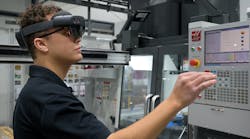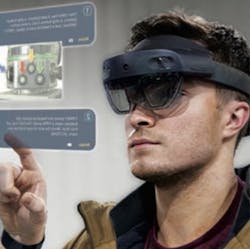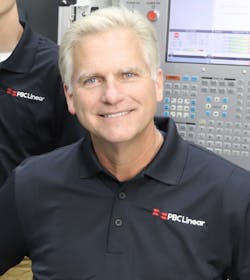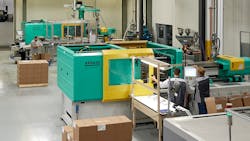Editor's Note: Tim LeCron, Director of Manufacturing Engineering, PBC Linear and Kelly Malone, Chief Customer Officer, Taqtile, will be presenting at The Manufacturing &Technology Show. being held in Cleveland, Ohio, Nov. 9-11, 2021.
Keeping manufacturing operations on track to consistently crank out quality parts has never been an easy task. And, in many ways, it continues to increase in complexity as tolerances tighten and customer expectations intensify.
At the same time, the skills gap has steadily grown. With baby boomers nearing retirement, it has become clear manufacturing has lost its appeal. The writing is on the wall. Dramatic change is necessary to make manufacturing exciting again. The future is coming–and fast.
Of course, this was true before COVID-19. Understandably, no one could predict the pandemic or the impact it would ultimately have on manufacturers. Suddenly, manufacturers face a new, socially distanced normal with emerging technologies, automation and robotics taking on new meaning.
Simply put, that future is now.
Embracing a New Reality
Like it has for many manufacturers, the pandemic has intensified the impact of the labor shortage for Roscoe, Illinois-based manufacturer PBC Linear. “The biggest problem was finding new people and getting them up to speed fast enough and then keeping them," says Beau Wileman, a design engineer tasked with managing the factory of the future initiative at PBC Linear. "It’s inefficient and expensive to have a manager step away from whatever he was doing and train them."
This situation led Wileman to explore the feasibility of deploying augmented reality, specifically Taqtile, as a means of reducing training time and lessening the need for manager supervision during the process. "We have since refined the process where 70% of training occurs through the headset,” he says.
Having AR technology in place means people like Tim Lecrone, director of research, development, and customer outreach at PBC Linear, do not spend an entire day training new employees who may jump when a higher wage opportunity surfaces in the Chicago area. Instead, the new operators watch basic instructions in the templates created and stored in the toolbox. There's a job instruction for everything associated with a part cycle including load, unload, inspection and downloading a program.
The process of navigating the augmented reality space was relatively easy, explains Wileman. “There was admittedly more of a learning curve bringing the veteran coordinators and machinists into the mix,” he says. "It was maybe five days for the older generation versus one or two days for the younger generation."
Wileman's team initially tried creating templates for everything, and quickly discovered they were spreading the sessions too thin. “However, when we started focusing our energy on tackling specific areas of the shop (lathes, mills, grinders), we found that we had more uniform depth and flow,” he says.
PBC Linear has also seen a lot of job applicants displaced from the hospitality industry and wanting to try something new. “Previously, we would discount these people without machining experience, but these new tools create new opportunities,” says Lecrone. “Now we have a powerful tool where people can leverage a tablet or HoloLens to learn a task and earn that paycheck. If they like it, they can go to the next level by learning the next set of instructions.”
The technology’s advantages go beyond process, says Wileman. “It enables us to keep the attention of younger people during training and also adds some excitement about doing the job. It makes manufacturing a little sexier and engaging. It's kind of similar to a video game environment with instructions popping up right in front of you.”
AR technology has also enabled PBC Linear to create new levels of consistency across the operator base. "We’ve discovered everybody has their own little spin on how a machine center should operate or what qualifies as a good part, even with inspection procedures and documents in place,” says Lecrone. “When everyone watches the same Manifest instructions, it creates a good tool to identify when certain operators need to revisit steps 13-15 to get them back on the same page of how we want our parts machined and inspected.”Of course, although AR has proven meaningful in addressing PBC Linear’s personnel issue, the potential for new use cases is sure to climb. Headset use has since expanded to include providing valuable information on the company's different product lines, robots and 3D printers. Wileman also foresees sees the technology playing an instrumental role in product support. "Being able to have customers use Manifest Connect and help them through any issues, even if we are 1,000 miles away, is a powerful application," he says. "We see a lot of scalability in how we approach this with our customers."
Nearing Lights Out
Embracing dedicated, easy-to-run work cells quickly surfaced as the future mode of operation for Rogers, Minnesota-based Metro Mold & Design. "Process stability leads to the operational simplicity,” says Ben Lampron, vice president of Metro’s consumer and industrial division. “We focus on engineering cells with the right equipment, the right trained technical staff and the automation to deliver."
"By being laser-focused on which projects we run in work cells, we can create environments where the chances of success are much higher,” he adds. “By eliminating the noise, we're able to produce in a more profitable way. The more we can pre-engineer the cell, the better. By the time we hand over a project, especially during COVID-19, we have to make sure that the operations team can take that product and run without worrying about any kinks in engineering.”
Strategic technology investments are a significant part of the work cells – everything from automatic-part moving, cobots with end-of-arm tooling and autonomous robots for material handling.
“Wherever we can automate handling or manufacturing, we do it,” Lampron says. “It's worth the investment and just kind of becomes the flywheel effect. For us, success is about ease of use, training and implementation across a portfolio of people. However, understanding people development is perhaps more important”; workers must be able to understand and embrace the automation. “If something goes down on a Saturday afternoon, the operator or technician needs to be able to fix everything.”
Of course, volume is necessary for Metro’s approach to work effectively. “You have to have enough volume to justify the spend, as well as the time needed to build up the cell and do the engineering upfront work,” says Lampron. “We focus on long-run, high-volume kind of manufacturing. It's important to realize those efficiencies.”
“It is kind of like an Easy Bake Oven at that point,” Lampron says. “You follow the instructions, run the parts, pack them up and ship them out. Separating the customer into its own dedicated room with all of the different operations eliminates noise and confusion.”
COVID-19 emphasized the significance of cross-training personnel–meaning those initially making tools now know how to hang molds, run presses, conduct inspections and prepare parts for delivery.
“Everybody who's within that cell environment knows how to do almost every job,” Lampron says. “It's really pays dividends and will continue in the future as we cross-train more folks in many different disciplines. If you have a dedicated work-cell environment, you can also be very specific about work instructions, because you know they are for just that cell. Everyone can easily follow them pretty quickly, even if it's outside of their normal job description.”
Work cells have become so successful at Metro that not only is everyone assigned to a cell capable of each key task; they have rapidly become a de facto extension of the customer's facility. “Not just from a manufacturing standpoint, but also engineering development and customer care perspective,” says Lampron. “The value we add isn't just delivering plastic components; it's understanding their business and supply chain enough that we can figure out ways to make their recipe for success better.”
According to Lampron, COVID-19 has probably contributed to this environment of openness. “You don't know who's going to be out on any particular day,” he says. “As a result, companies welcome help where they can find it. and we have been able to leverage our expertise in a deeper way than just making plastic parts.”
There will always be people problems in manufacturing. Even before the pandemic, finding enough talent (from operators to executive engineers) to run the shop was a constant struggle. Creating dedicated work cells is even more important when you cannot find talent; you need to take the human being out of it as much as you can.








